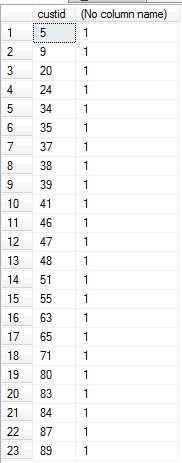标签:style blog http io ar color os 使用 sp
原文:SQL点滴10—使用with语句来写一个稍微复杂sql语句,附加和子查询的性能对比今天偶尔看到sql中也有with关键字,好歹也写了几年的sql语句,居然第一次接触,无知啊。看了一位博主的文章,自己添加了一些内容,做了简单的总结,这个语句还是第一次见到,学习了。我从简单到复杂地写,希望高手们不要见笑。下面的sql语句设计到三个表,表的内容我用txt文件复制进去,这里不妨使用上一个随笔介绍的建立端到端的package的方法将这些表导入到数据库中,具体的就不说了。
从这里下载文件employees.txt,customers.txt,orders.txt
参考文章:http://www.cnblogs.com/wwan/archive/2011/02/24/1964279.html
使用package导入数据:http://www.cnblogs.com/tylerdonet/archive/2011/04/17/2017471.html
简单的聚合
从orders表中选择各个年份共有共有多少客户订购了商品
1select YEAR(o.orderdate) orderyear,COUNT(distinct(custid)) numCusts
2from Sales.Orders o
3group by YEAR(o.orderdate)
4go
1select orderyear,COUNT(distinct(custid))numCusts
2from (select YEAR(orderdate) as orderyear,custid from sales.orders) as D
3group by orderyear
4go
1select orderyear,COUNT(distinct(custid)) numCusts
2from (select YEAR(orderdate),custid from sales.orders) as D(orderyear,custid)
3group by orderyear
4go
1with c as(
2select YEAR(orderdate) orderyear, custid from sales.orders)
3select orderyear,COUNT(distinct(custid)) numCusts from c group by orderyear
4go
----MSDN
1 with c(orderyear,custid) as(
2 select YEAR(orderdate),custid from sales.orders)
3 select orderyear,COUNT(distinct(custid)) numCusts from c group by c.orderyear
4 go
 图1
图1添加计算
1 with yearcount as(
2 select YEAR(orderdate) orderyear,COUNT(distinct(custid)) numCusts from sales.orders group by YEAR(orderdate))
3 select cur.orderyear curyear,cur.numCusts curNumCusts,prv.orderyear prvyear,prv.numCusts prvNumCusts,cur.numCusts-prv.numCusts growth
4 from yearcount cur left join yearcount prv on cur.orderyear=prv.orderyear+1
5 go

复杂的计算
1 with TheseEmployees as(
2 select empid from hr.employees where country=‘USA‘),
3 CharacteristicFunctions as(
4 select custid,
5 case when custid in (select custid from sales.orders as o where o.empid=e.empid) then 1 else 0 end as charfun
6 from sales.customers as c cross join TheseEmployees as e)
7 select custid,min(charfun) from CharacteristicFunctions group by custid having min(charfun)=1
8 go

这里只有简单地介绍,没有深入,高手们不要见笑啊。
---------------------------------------------------------分界线----------------------------------------------------------
with语句和子查询的性能比较
在博友SingleCat的提醒下,对with语句做一些性能测试,这里使用的测试工具是SQL Server Profile。我选择了最后一个语句,因为这个语句比较复杂一点。开始的时候单独执行一次发现他们的差别不大,就差几个毫秒,后来想让他们多执行几次,连续执行10
次看看执行的结果。下面贴出测试用的语句。
2 declare @withquery varchar(5000)
3 declare @execcount int=0
4 set @withquery=‘with TheseEmployees as(
5 select empid from hr.employees where country=N‘‘USA‘‘),
6 CharacteristicFunctions as(
7 select custid,
8 case when custid in (select custid from sales.orders as o where o.empid=e.empid) then 1 else 0 end as charfun
9 from sales.customers as c cross join TheseEmployees as e)
10 select custid from CharacteristicFunctions group by custid having min(charfun)=1 order by custid
11 ‘
12 while @execcount<10
13 begin
14 exec (@withquery);
15 set @execcount=@execcount+1
16 end
17
18 /*子查询*/
19 declare @subquery varchar(5000)
20 declare @execcount int=0
21 set @subquery=‘select custid from Sales.Orders where empid in
22 (select empid from HR.Employees where country = N‘‘USA‘‘) group by custid
23 having count(distinct empid)=(select count(*) from HR.Employees where country = N‘‘USA‘‘);
24 ‘
25 while @execcount<10
26 begin
27 exec (@subquery);
28 set @execcount=@execcount+1
29 end
从SQL Server Profile中截图如下

从图中可以看到子查询语句的执行时间要少于with语句,我觉得主要是with查询中有一个cross join做了笛卡尔积的关系,于是又实验了上面的那个简单一点的,下面是测试语句。
1 /*with语句*/
2 declare @withquery varchar(5000)
3 declare @execcount int=0
4 set @withquery=‘with c(orderyear,custid) as(
5 select YEAR(orderdate),custid from sales.orders)
6 select orderyear,COUNT(distinct(custid)) numCusts from c group by c.orderyear‘
7 while @execcount<100
8 begin
9 exec (@withquery);
10 set @execcount=@execcount+1
11 end
12
13 /*子查询*/
14 declare @subquery varchar(5000)
15 declare @execcount int=0
16 set @subquery=‘select orderyear,COUNT(distinct(custid)) numCusts
17 from (select YEAR(orderdate),custid from sales.orders) as D(orderyear,custid)
18 group by orderyear‘
19 while @execcount<100
20 begin
21 exec (@subquery);
22 set @execcount=@execcount+1
23 end
这次做10次查询还是没有多大的差距,with语句用10个duration,子查询用了11个,有时候还会翻过来。于是把执行次数改成100,这次还是子查询使用的时间要少,截图如下

最终结论,子查询好比with语句效率高。
SQL点滴10—使用with语句来写一个稍微复杂sql语句,附加和子查询的性能对比
标签:style blog http io ar color os 使用 sp
原文地址:http://www.cnblogs.com/lonelyxmas/p/4140430.html